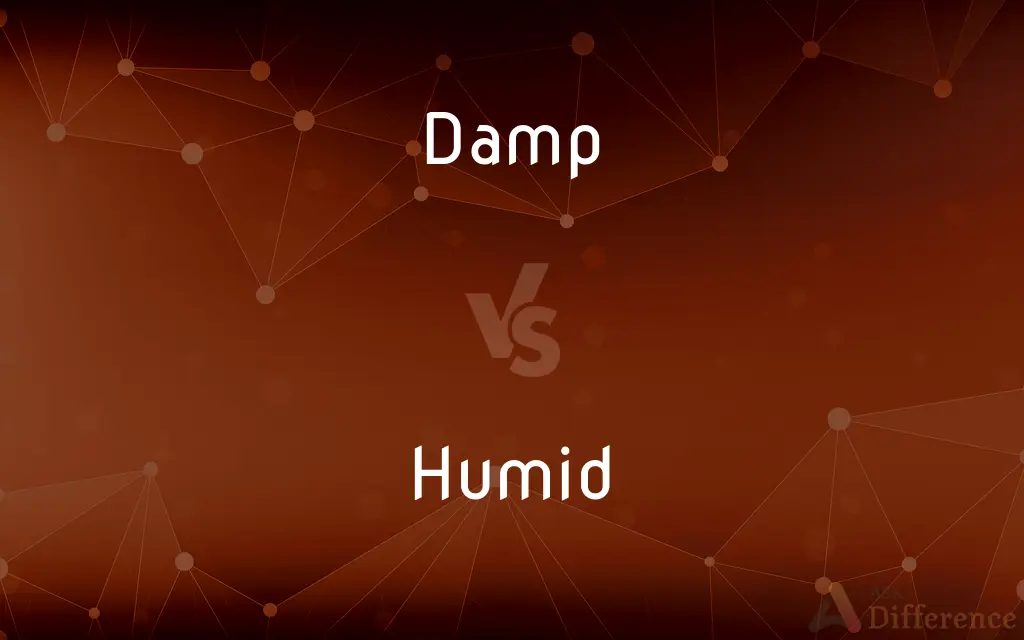Damp vs. Humid — What's the Difference?
By Maham Liaqat & Urooj Arif — Updated on March 10, 2024
Damp refers to surfaces or materials that are slightly wet, while humid describes air with a high moisture content.

Difference Between Damp and Humid
Table of Contents
ADVERTISEMENT
Key Differences
Dampness is a condition often associated with materials or surfaces, indicating that they are slightly wet or moist. This can result from exposure to liquid, condensation, or a lack of adequate drying. The presence of dampness is typically localized, affecting specific areas or items, such as damp walls or clothing. On the other hand, humidity is a measure of the amount of water vapor present in the air. High humidity levels make the air feel more moist, influencing not just the perception of warmth or coolness but also affecting comfort levels, health, and the condition of objects within that environment.
While damp is usually considered undesirable because it can lead to mold growth, structural damage, and a musty smell, humidity is a more general condition that can vary in desirability depending on the context. High humidity can be uncomfortable for people, potentially aggravating respiratory conditions and making physical activities more strenuous. However, certain levels of humidity are necessary for human comfort and the well-being of many plants and animals. In contrast, too little humidity can lead to dry air that can cause skin irritation and respiratory problems.
The causes of damp and high humidity differ significantly. Dampness in homes and buildings is often due to water intrusion from leaks, poor ventilation, or condensation. Addressing dampness usually requires identifying and rectifying the source of moisture, such as fixing leaks or improving ventilation. Humidity, on the other hand, is influenced by weather patterns, geographical location, and seasonal changes. Managing indoor humidity levels might involve the use of humidifiers or dehumidifiers, air conditioning systems, or changes in lifestyle and home maintenance routines.
In terms of measurement and control, dampness is typically identified through visual inspection and touch, such as noticing wet patches or feeling moisture on surfaces. Instruments like moisture meters can quantify the moisture content in materials. Humidity is measured with a hygrometer, providing a percentage that represents the current level of water vapor in the air relative to the maximum it can hold at that temperature. Controlling dampness and humidity involves different strategies tailored to either removing excess moisture from materials and surfaces or adjusting the water vapor content of the air.
Both damp and humid conditions can have significant impacts on health and the integrity of structures and possessions. Prolonged exposure to damp environments can lead to health issues like allergies and respiratory problems due to mold and mildew growth. High humidity can exacerbate these issues by promoting further growth of mold and dust mites. However, maintaining an optimal level of humidity is crucial for creating a healthy and comfortable living environment, highlighting the importance of balance in managing moisture in both air and materials.
ADVERTISEMENT
Comparison Chart
Definition
Refers to surfaces or materials that are slightly wet
Describes air with a high moisture content
Desirability
Generally undesirable due to potential for mold and structural damage
Varies; too high or too low can be uncomfortable
Causes
Water intrusion, condensation, lack of drying
Weather patterns, geographic location, indoor activities
Measurement
Visual inspection, touch, moisture meters
Hygrometer measures water vapor in air
Control
Fixing leaks, improving ventilation
Using humidifiers/dehumidifiers, air conditioning
Compare with Definitions
Damp
Measured by moisture content in materials.
The contractor used a moisture meter to detect damp in the floorboards.
Humid
Air with a high moisture content.
The weather was extremely humid today, making it feel hotter.
Damp
Slightly wet surfaces or materials.
The walls felt damp after the heavy rain.
Humid
Influenced by external and internal factors.
Cooking and showering without ventilation can increase indoor humidity.
Damp
Usually undesirable in homes and buildings.
They hired a professional to deal with the damp in their house.
Humid
Controlled through ventilation and devices.
They installed a dehumidifier to reduce the humidity levels in their home.
Damp
Requires addressing the source of moisture.
Fixing the leak stopped the dampness on the ceiling.
Humid
Can affect comfort and health.
Humid conditions often aggravate her asthma.
Damp
Can lead to mold growth and structural damage.
Damp conditions in the basement caused mold on the walls.
Humid
Desirability depends on level and context.
The greenhouse requires a humid environment for the plants to thrive.
Damp
Slightly wet
A damp sponge.
Humid
Marked by a relatively high level of water vapour in the atmosphere
A hot and humid day
Damp
Humid
Damp air.
Humid
Containing or characterized by a high amount of water or water vapor
Humid air.
A humid evening.
Damp
(Archaic) Dejected; depressed.
Humid
Containing perceptible moisture (usually describing air or atmosphere); damp; moist; somewhat wet or watery.
Humid earth
Damp
Moisture in the air; humidity
Come in out of the damp.
Humid
Containing sensible moisture; damp; moist; as, a humidair or atmosphere; somewhat wet or watery; as, humid earth; consisting of water or vapor.
Evening cloud, or humid bow.
Damp
Moisture that lies or has condensed on something
“I saw the damp lying on the bare hedges and spare grass” (Charles Dickens).
Humid
Containing or characterized by a great deal of water vapor;
Humid air
Humid weather
Damp
Foul or poisonous gas that sometimes pollutes the air in coal mines.
Damp
Lowness of spirits; depression
“An angry or sorrowful [countenance] throws a sudden damp upon me” (David Hume).
Damp
A restraint or check; a discouragement
“The issue of arms was so slow as to throw a great damp upon volunteering” (James Franck Bright).
Damp
To make damp or moist; moisten.
Damp
To suppress or extinguish (a fire) by reducing or cutting off air.
Damp
To restrain or check
News that damped our enthusiasm.
Damp
(Music) To slow or stop the vibrations of (the strings of a keyboard instrument) with a damper.
Damp
(Physics) To decrease the amplitude of (an oscillating system).
Damp
In a state between dry and wet; moderately wet; moist.
The lawn was still damp so we decided not to sit down.
The paint is still damp, so please don't touch it.
Damp
(figuratively) Despondent; dispirited, downcast.
Damp
Permitting the possession of alcoholic beverages, but not their sale.}}
Damp
Moisture; humidity; dampness.
Damp
(archaic) Fog; fogginess; vapor.
Damp
(archaic) Dejection or depression; something that spoils a positive emotion (such as enjoyment, satisfaction, expectation or courage) or a desired activity.
Damp
A gaseous product, formed in coal mines, old wells, pits, etc.
Damp
To dampen; to make moderately wet
To damp cloth
Damp
To put out, as fire; to weaken, restrain, or make dull.
Damp
(transitive) To suppress vibrations (mechanical) or oscillations (electrical) by converting energy to heat (or some other form of energy).
Damp
Moisture; humidity; fog; fogginess; vapor.
Night . . . with black airAccompanied, with damps and dreadful gloom.
Damp
Dejection; depression; cloud of the mind.
Even now, while thus I stand blest in thy presence,A secret damp of grief comes o'er my soul.
It must have thrown a damp over your autumn excursion.
Damp
A gaseous product, formed in coal mines, old wells, pints, etc.
Damp
Being in a state between dry and wet; moderately wet; moist; humid.
O'erspread with a damp sweat and holy fear.
Damp
Dejected; depressed; sunk.
All these and more came flocking, but with looksDowncast and damp.
Damp
To render damp; to moisten; to make humid, or moderately wet; to dampen; as, to damp cloth.
Damp
A slight wetness
Damp
Restrain or discourage;
The sudden bad news damped the joyous atmosphere
Damp
Make vague or obscure or make (an image) less visible;
Muffle the message
Damp
Lessen in force or effect;
Soften a shock
Break a fall
Damp
Slightly wet;
Clothes damp with perspiration
A moist breeze
Eyes moist with tears
Common Curiosities
What are common causes of damp?
Common causes include leaks, flooding, poor ventilation, and condensation from temperature differences.
How does humidity affect the air?
Humidity represents the amount of water vapor in the air, affecting how moist the air feels and influencing temperature perception, comfort, and health.
Why is high humidity uncomfortable?
High humidity can make the air feel sticky and warmer than it actually is, hinder sweat evaporation, and exacerbate certain health conditions.
What are the health risks of prolonged exposure to damp?
Prolonged exposure can lead to respiratory problems, allergies, and asthma due to mold and mildew growth.
What level of humidity is considered comfortable?
A comfortable indoor humidity level is typically between 30% and 50%.
What defines a damp environment?
A damp environment is characterized by surfaces or materials that are slightly wet or moist, often due to exposure to water or inadequate drying.
How is indoor humidity managed?
Indoor humidity is managed through the use of humidifiers or dehumidifiers, proper ventilation, air conditioning, and monitoring with hygrometers.
Can damp and humid conditions coexist?
Yes, damp conditions can be present in areas of localized moisture, while the overall air can be humid, each affecting environments differently.
How do weather patterns influence humidity?
Weather patterns, such as rain, snow, and temperature fluctuations, directly affect outdoor and subsequently indoor humidity levels.
Can dampness occur without high humidity?
Yes, dampness can occur in specific areas due to localized water exposure or condensation, even if the overall air humidity is not high.
Can dampness affect the structural integrity of buildings?
Yes, prolonged dampness can weaken building materials and lead to structural damage.
What is a hygrometer used for?
A hygrometer is used to measure the level of humidity in the air, helping to maintain optimal indoor conditions.
Is it easier to control dampness or humidity?
Controlling dampness often requires addressing specific sources of moisture, while humidity can be adjusted more broadly with devices like humidifiers or dehumidifiers.
How do plants respond to humid conditions?
Many plants thrive in humid conditions as it helps them retain moisture, though too much humidity can also lead to fungal diseases.
Share Your Discovery

Previous Comparison
Tart vs. Cake
Next Comparison
Style vs. TrendAuthor Spotlight
Written by
Maham LiaqatCo-written by
Urooj ArifUrooj is a skilled content writer at Ask Difference, known for her exceptional ability to simplify complex topics into engaging and informative content. With a passion for research and a flair for clear, concise writing, she consistently delivers articles that resonate with our diverse audience.














































